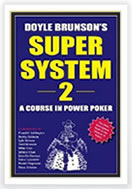 |
Author: Doyle Brunson Publisher: Cardoza Publishing Pages: 640 Pub. Date: 2009 (2nd Edition) Price: $19.77 |
Book Review: Part 2
| Brunson called on his own son, Todd, to write the section on limit seven-card stud hi/lo, often called stud-8. As with Omaha hi/lo, stud hi/lo is a game where pots are often split, and as with Baldwin and Gregorich in earlier section, the junior Brunson lays out a competent framework for stud hi/lo competence. The game is a regional favorite, played most often on America’s East Coast and upper Midwest, but the game’s inclusion in H.O.R.S.E. and H.O.S.E. rotation games and tournaments makes it a vital piece of any versatile poker player’s skill set, hence its inclusion here in Super System 2.No poker variant has shown more growth in recent years than pot-limit Omaha high, particularly in Europe, and so its inclusion as part of Super System 2 was a slam dunk. Brunson tabbed veteran PLO expert Lyle Berman for this section. Berman correctly notes that pot-limit Omaha is the “pot limit” game of choice in the poker world, being far more popular than pot-limit hold’em, and his section on the game is a solid jumping-off point for players new to the discipline. Berman starts here with the conceptual basics, noting PLO’s volatility, its conduciveness to action, its relative resistance to radical bluffing and its core element of thin edges. It’s a gambler’s, action-junkie’s game, heavily dependent on table position and a recognition of pot odds. Berman flips the book’s standard format a bit – most other chapters start simple and add in more advanced concepts slowly – while Berman splashes around from simple to advanced and back again. It’s an oddly good fit for the game, and Berman duly explores such Omaha-specific topics as always holding or drawing to the nuts, being wary of the “underfull” (an often-beaten full house, and of course, that bane of any Omaha player’s existence – the best ways to play aces. It’s a good read, perhaps no longer the best available now that many PLO-specific books have been published, but within the scope of Super System 2 it more than holds its own.Next up is “Kid Poker” himself, Daniel Negreanu, with a section on triple draw. Triple draw is a lowball game wherein the object is to make the best possible “low” hand, which can be either A-2-3-4-5 (ace-to-five), or 2-3-4-5-7 (deuce-to-seven), depending on the game. Triple draw is a specialty game that can be found both online and in larger casino venues, and it enjoys a core audience of players. It’s often found in high-limit rotations which include several different variants, though its inclusion in major tourneys is often only as part of an “eight game” tournament mix. Ace-to-five and deuce-to-seven are simply two versions of the same core game, and Negreanu explores basic strategies that should serve beginners well. Negreanu explores ace-to-five play in particular, though the lessons taught are of equal value in deuce-to-seven.From there the book returns to Doyle Brunson’s own hands. First comes a very brief, perhaps even superficial section on tournaments, and then it’s on to a detailed look at no-limit Texas hold’em. In the original Super/System, Brunson’s section on no-limit Texas hold’em was three times the length of any other section, befitting the game’s dominance of the poker world and Brunson’s own success. No-limit Texas hold’em was introduced to Las Vegas by Brunson and others, and it was the game in which Brunson made most of his personal fortune. Here Brunson updates the many concepts he first laid out some 25 years earlier. Following the publication of Super/System, Brunson remarked that if he had to do it all over again, he wouldn’t have written the book. Instead, a quarter century later, he wrote a second one. Brunson explores some of the game’s core concepts, then spends several dozen pages exploring how his thought processes in playing several important holdings throughout s hand – AK, QQ and the like. This is valuable stuff, dishing up second- and third-level poker thinking in a breezy, casual manner that should be of permanent benefit to a wide range of players.Several other sections in the book offer less or little or nothing in the way of game strategy. These include Crandall Addington’s history of the WSOP, the Lipscomb section on the WPT, Johnny Chan’s forgettable preface, and a short autobiographical section by Doyle Brunson himself – this rendered far less vital by the subsequent publishing of a more recent, more detailed Brunson biography. Brunson also added in a section on online poker, which includes a number of solid concepts but also manages to come off as curiously dated in the few years that have elapsed since the book’s release. It’s a bit of a commercial, too, promoting Brunson’s own interests in the DoylesRoom.com online room. Perhaps the best of the non-game-specific sections is the Mike Caro offering, “43 Exclusive Super/System 2 Tips from Mike Caro University.” Caro, a longtime Brunson friend, contributor to Super/System and author of the seminal Book of Tells, offers up a bit of advertorial here that still is well worth the read. Caro’s section, as with much of his other work, focuses on the thought processes behind the game – tilt control, bankroll management, reading opponents – in single-line quips perhaps best suited to a page-a-day desk calendar. Still, Caro’s thoughts offer a nice counterbalance to much of the other game-specific material.
Overall, Super System 2 offers so much good material that a player looking to improve his game would be foolish not to have the game and learn its lessons. The massive book requires a handful of hours to read and many more to understand, yet it stands among the most vital of all poker strategy offerings. |